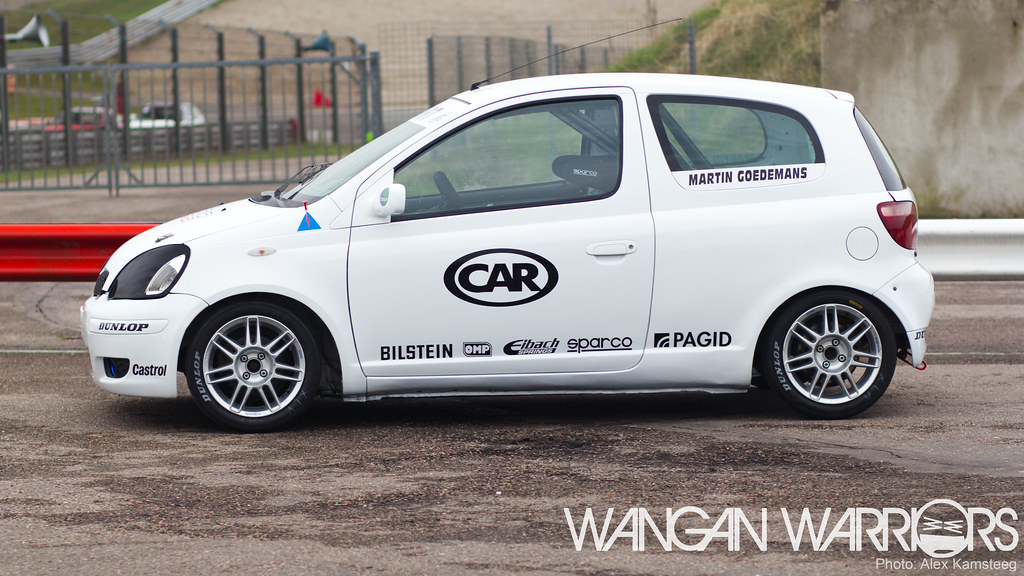When I started at my first full time job three years ago I needed a car because getting there by public transport is almost impossible. I looked around, did some test drives and ultimately I bought a car nobody associates with a young guy, a Toyota Yaris. The Yaris, also known as the Vitz in Japan or the Echo in North-American countries, has the reputation of being a car for the elderly people.

The week after I bought my car I joined the Dutch Yaris Club and I started modifying my car to my liking, which is not so easy with a Yaris because there are almost no aftermarket parts available except some plastic fantastic ugly bodykits and lights. So I was quite surprised when I discovered there was a big championship with the Yaris from 2001 to 2006 with almost 30 drivers participating. This was called the Yaris Cup, and the cars are called the Toyota Yaris Cup car. Some of these cars ended up in private hands and a few of these owners are also a member of the Yaris Club. When I read that one owner would bring his car to the Japanese Autosport Festival in Zandvoort I immediately contacted him and asked if I could take some pictures.

This particular car is a original Yaris Cup car. It was driven by Sheila Verschuur and it’s now owned by Martin Goedemans, a former Yaris Cup driver. From a distance the car looks like a normal Yaris, it doesn’t even have a bodykit fitted, but from up close a few differences become clear. Some of the bodywork is made from plastic instead of metal, there’s only one windscreen wiper on the front and the one on the back is completely removed.

On the inside the differences from a normal car are more clear. A complete FIA-approved roll cage is fitted, the interior is completely stripped and the driver sits in a Sparco bucket seat. Martin made some changes to the heating and ventilation of this car, because the Yaris Cup engine had a tendency to overheat Martin decided to funnel the air from the heater that normally warms the foot wells to the outside of the car. This way he can turn the heater up for extra cooling when the engine temperatures rises without turning the inside of the car into an oven.

In all Yaris models except the new 2012 model the gauge cluster is mounted in the centre of the dash. This works remarkably well in daily traffic but on the track you want some information directly in your viewfield, so the Yaris Cup is fitted with a cluster from Stack. It has a big tachometer with a LCD-screen for things like temperatures, oil pressure.

Under the bonnet I expected to see the 1.5 litre 1NZ-FE engine from a T-Sport model, but the Yaris Cup used a 1300cc 2NZ-FE. From the outside the engine looks remarkably the same as the engine in my own Yaris, it even has the plastic engine cover and the stock manifolds. There are some differences however, it produces 115 BHP instead of the normal 87 thanks to more aggressive cams, stronger valves and valve springs and a special ECU. This enables the engine to rev to 7400rpm, almost 1000 revs more than a stock engine. The gearbox has much shorter gear ratios than the normal Toyota C56 boxes used in a road-going Yaris, this limits the top speed but the car accelerates very, very quick.

This car is not a show queen, it isn’t road legal and Martin built it for track usage. At the end of the day Martin drove for 20 minutes on the track for the first time with this Yaris. He started a bit careful, of course, with some slow laps and some spectators were wondering what that little car was doing on the track. The other cars like a Lotus Elise and a Subaru Impreza looked incredibly fast compared to the tiny Yaris.

That changed when Martin decided to do some hot laps. Suddenly he was not only keeping up with the other cars, but also overtaking them. It still didn’t look spectacular, I expected to see some nervous fish tailing when braking hard at the end of the straight due to the very light and empty rear of the car but it looked very stable and no screaming tyres in the corners. But even without all the drama you could see it was very fast. In the Yaris Cup championship the drivers managed to do a lap at Zandvoort in about 2 minutes and 9 seconds. Considering most of the cars in the Dutch Time Attack championship with comparable lap times are having much more horsepower we can call this quick, very quick.
Most of the times when a factory-backed championship ends the cars are scrapped. Sometimes a few of them end up in private hands but when spare parts are getting more and more difficult to obtain most of these are scrapped too. I did some searching and I discovered that at least five of the Cup cars are still in existence and every single one of them is still used as a track tool. Because the championship ended six years ago, and thus the parts supply, it’s quite remarkable to see a Cup car return to racing and it would be fun to see Martin again in the near future while he pushes this little Yaris to the limits on the track.
– Alex Kamsteeg
Photos by Alex Kamsteeg





